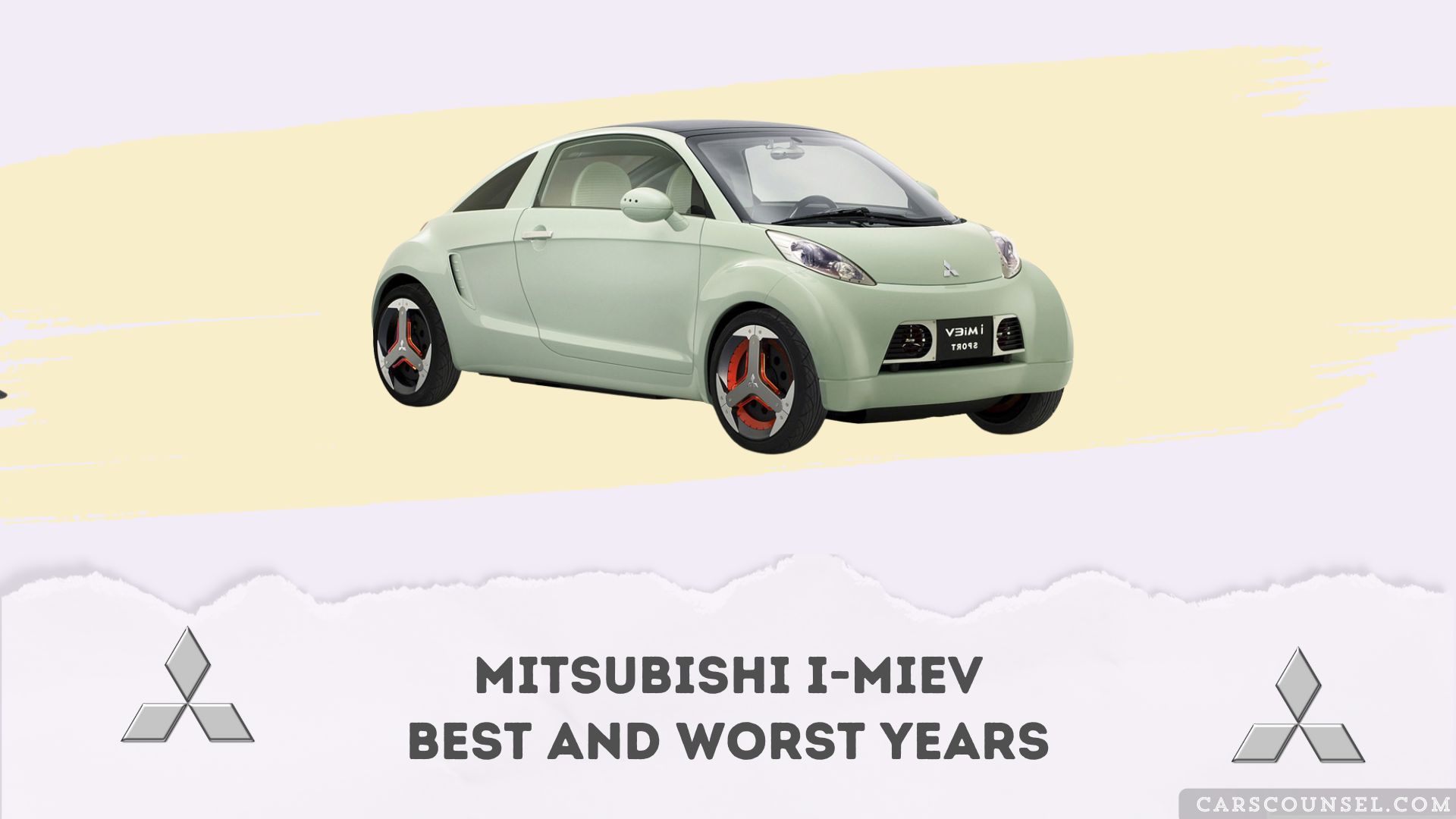You’re considering buying a used Mitsubishi I-Miev, and you’ve heard mixed reviews. Take, for instance, your friend who’s had a 2012 I-Miev and has been plagued by issues with airbag deployment.
On the other hand, your coworker swears by their 2016 model, citing its reliability and low maintenance costs. What’s going on here? It’s clear that the I-Miev’s reliability varies significantly across model years – but which ones should you avoid, and which ones are worth considering?

Quick Navigation
Key Takeaways
- The 2012 and 2013 models are the worst years to buy a used Mitsubishi I-Miev due to significant issues reported.
- The 2016 model has fewer significant issues reported and is a reliable model year to consider.
- The 2017 model is the most refined and reliable model year with improved cells and warranty coverage.
- The 2017 model has improved cells that should age better, making it a better choice for those concerned about range.
- Avoid the 2014 model year due to lack of documentation on reliability and mixed user reviews.
Overview of the Mitsubishi I-Miev
As you investigate the Mitsubishi i-MiEV, you’ll discover a budget-friendly electric vehicle that’s packed with impressive features.
With a 62 miles on a single charge, according to EPA ratings. The i-MiEV’s top speed is approximately 80 mph, making it suitable for city driving.
Its hatchback design offers surprising cargo space, making it ideal for daily errands.
Plus, with fewer moving parts, the i-MiEV holds up well reliability-wise, leading to lower maintenance costs over time.
Model Years to Avoid and Their Issues
When shopping for a pre-owned i-MiEV, you’ll want to steer clear of certain model years that are plagued by issues. The 2012 and 2013 models have the most reported issues, making them the worst years to buy a used Mitsubishi i-MiEV.
| Model Year | Issues | Recommendation |
|---|---|---|
| 2012 | Airbag deployment, brake vacuum pump failure | Avoid |
| 2013 | Short range, battery deterioration, brake vacuum pump issues | Avoid |
| 2014 | Lack of documentation on reliability, mixed user reviews | Avoid |
Most Reliable Model Years and Their Benefits
You’ll find that the most reliable Mitsubishi i-MiEV model years are the 2016 and 2017, with the latter being the most reliable due to its limited issues and positive reviews.
As the final model year before discontinuation, the 2017 i-MiEV is often regarded as the most refined and reliable of the lineup.
With improved cells that should age better and a warranty that covers battery health, you can drive away with confidence.
Reliable Model Years
If you’re looking for a reliable Mitsubishi i-MiEV, limited information on its reliability can actually work in your favor. The 2016 and 2017 models stand out as reliable model years. Here’s a breakdown of the benefits:
| Model Year | Reliability | Benefits |
|---|---|---|
| 2016 | Good | Fewer significant issues reported |
| 2017 | Excellent | Most refined and reliable model year, improved cells, warranty coverage |
| 2016-2017 | Reliable | Fewer reported issues, improvements over the years |
| 2017 | Best | Final year before discontinuation, positive user reviews |
These later models have fewer reported issues and benefit from improvements made over the years.
Limited Issues Found
The Mitsubishi i-MiEV’s reliability benefits are most pronounced in its later years, with limited issues found in the 2016 and 2017 models.
You’ll find that these models have fewer significant problems, making them a more reliable option.
The 2017 model, in particular, stands out with limited complaints and positive user reviews.
This is likely due to the improvements made over the years, resulting in fewer reported issues.
Refined Final Model
As you venture the most reliable model years of the Mitsubishi i-MiEV, it’s clear that the final model year stands out from the rest.
The 2017 model is often regarded as the most refined and reliable of the lineup. With limited complaints and positive user reviews, it’s no surprise that this model year benefits from improvements made over the years, resulting in fewer reported issues.
Additionally, the 2017 model features improved cells that should age better, and it comes with a warranty, making it a great choice for those looking for a reliable ride.
Additional Information and Features
You’ll appreciate the Mitsubishi i-MiEV’s compact size, making it perfect for city driving,
while its hatchback design offers surprising cargo space for its size. This combination provides an ideal blend of convenience and practicality.
Its compact dimensions make it easy to maneuver in tight urban spaces, giving you more flexibility on the go.
Compact City Driving
Compact city driving is where the Mitsubishi i-MiEV truly shines.
You’ll appreciate its compact size, which makes traversing tight city streets and finding parking in crowded urban areas a breeze.
- The i-MiEV’s top speed of approximately 80 mph is sufficient for city driving, where speed limits are typically lower.
- The car’s electric motor and compact size work together to make it perfect for city dwellers.
- You’ll be surprised by the cargo space this hatchback design offers, despite its small size.
- The i-MiEV’s compact size allows for easy maneuverability in crowded city streets, making it easy to pilot through the urban landscape.
Practical Cargo Space
The Mitsubishi i-MiEV’s hatchback design provides a surprising amount of cargo space, making it a practical choice for city dwellers who need to transport gear, groceries, or other essential items. You’ll appreciate the roomy interior, which can accommodate various items. Here’s a breakdown of the cargo space:
| Cargo Space | Dimensions | Capacity |
|---|---|---|
| Rear Seat Up | 39.4 in x 18.7 in x 14.7 in | 13.0 cu. ft. |
| Rear Seat Down | 62.0 in x 18.7 in x 23.6 in | 26.6 cu. ft. |
| Maximum Cargo Length | 63.0 in | – |
With its compact size and hatchback design, the i-MiEV offers a unique combination of city-friendly driving and practical cargo space.
Range Comparison
When shopping for a used i-MiEV, range is clearly a critical contemplation, but it’s essential to look beyond the numbers.
You might be surprised to learn that the 2012 model has more range than the 2017 model, but don’t let that be the sole deciding factor.
- Battery capacity is critical, but not the only aspect to ponder when evaluating range in a used i-MiEV.
- How, when, and where the car is driven are important factors to ponder when evaluating range in a used i-MiEV.
- Range is probably just a revision in the way the range is estimated by the EPA.
- The 2017 model has improved cells that should age better, making it a better choice for those concerned about range.
- Range isn’t the only factor, so ponder other aspects like practical cargo space.
Battery Health
You’re considering battery health as a key factor in your used i-MiEV purchase, and rightly so – it’s essential to comprehend the battery’s condition to guarantee reliable range and overall performance.
A 2017 model’s improved cells and warranty provide added assurance. However, a well-maintained older model might’ve a better State of Health than a poorly maintained 2017 model.
Monitor battery capacity using an OBDII adapter to track battery health and identify potential issues early on. Regular checks will help prevent range decreases, ensuring your i-MiEV performance.
Used Car Considerations
Buying a used i-MiEV requires careful consideration of several key factors beyond its electric powertrain.
You’ll want to explore into the car’s history, including any exposure to salt, which can impact its overall condition.
- Check the car’s history, especially the OBDII adapter, to confirm there are no hidden issues or problems that need to be addressed.
- Find out if the Onboard Charger (OBC) has been replaced, as this can affect the overall reliability and performance.
- Check the 12v battery and OBC replacement cost, as these can be significant expenses down the line.
- Inspect normal mechanical things like the condition, brakes, and suspension.
- Review the car’s maintenance records to confirm it’s been properly serviced.
I-Miev Model Differences
Two primary trim levels make up the Mitsubishi i-MiEV lineup: the base SE model and the upscale ES model.
You’ll notice the ES model boasts a CHAdeMO quick charger, whereas the SE model does not.
The ES model also features a more advanced audio system, navigation, and a rearview camera, whereas the SE model has a basic audio system.
Additionally, the ES model offers heated front seats, a leather-wrapped gearshift knob, and more safety features like a rear parking sensor and lane departure warning system, making it a more premium option.
Design and Features
Compact in size, the Mitsubishi i-MiEV is ideal for traversing city streets, and its hatchback design provides a surprising amount of space for its size.
You’ll find:
- Climate control and Bluetooth audio, but mediocre materials and cheaply made interior
- Flat, unsupportive seat bottoms and standard door storage pockets
- Three-dial air conditioning control stack that significantly reduces range when in use
- Cheap plastics and poor seat padding and contours throughout the interior
- Air conditioning robs the car of a significant amount of range
When looking at performance cars, make sure to check out our guides on models like the Mitsubishi pajero, Mitsubishi outlander, Mitsubishi Mirage and Mitsubishi Galant. Knowing which model years to target and which to avoid is crucial. Our expert reviews break down these models, providing insights into the years that are celebrated for their engineering excellence and driving satisfaction, as well as those that are best to avoid due to potential issues.

